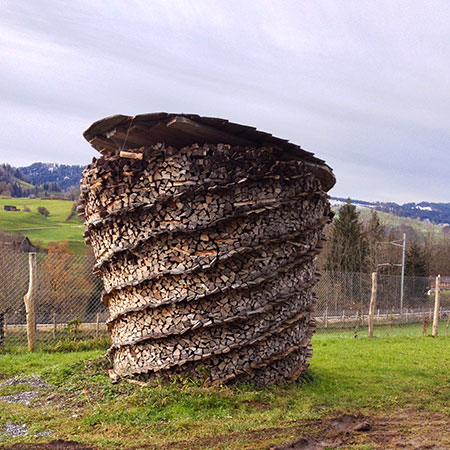Splitting firewood: is there a right way?
 I’m taking a deep breath…and swinging. Let’s talk about splitting and stacking firewood.
I’m taking a deep breath…and swinging. Let’s talk about splitting and stacking firewood.
What got me started on this? My friend David from Rossie shared a link to a NY Times article about Norwegians’ passionate interest in splitting and stacking wood the correct way–except “correct” seems to be open to interpretation. I suspect this is true around here, too.
I split–or “chopped”–firewood for many years. I used a chainsaw for a few years when I was younger and then decided I was too accident-prone to safely operate a device that could easily remove more than the kind of limbs that grow on trees. So I left the chainsaws to others and stuck with the other half of the process. I’ve always liked chopping and stacking firewood–well, mostly. Gnarly, damp, unfrozen elm? Not so much.
I’m no lumberjack, but I’m not afraid of an axe or maul. I only hit myself on the head with an axe once–splitting wood mid-winter in our low-ceilinged basement. This is probably where it makes sense to share the how-to article , better yet, this one from Mother Earth News, a magazine I was for sure reading back when I first picked up an axe.
If you’re going to chop wood for any length of time, conserving your physical energy is important. It’s hard work. Here’s a trick that lots of people use:
Or even easier, you can sell out, as we recently did, and use an engine-driven log-splitter. I have to admit, after years of using an axe, the log-splitter is like getting running water instead of pulling buckets out of a well. Log-splitters pretty much deal with anything–including long, damp, gnarly elm.
As for stacking wood, well, you can check out the link to the Norwegians above and let me know what rules you follow or how you go about stacking. Of course, there’s an art to it, I mean ART, like this amazing construction by sculptor John Van Alstine whose “woodpile” was featured as our Artwork of the Day last fall:
Everyone has their own ideas about splitting wood and I’m counting on you to add tips, warnings and tales of the wood pile. And, oh yeah, how’s your woodpile holding up this winter?
Tags: firewood, heating with wood, splitting wood, woodpile









I like that tire trick!
When I moved to the North Country 35 years ago, we built a little cabin in Russell. We had neighbors across the road who were in their mid seventies, who heated and cooked with wood. You could tell time by Perry’s wood chopping; He’d split wood from 6:30 to 7:00 every morning while Anna made his breakfast. Just a half hour a day kept him a year or two ahead of the game. His wood was perfectly split, stacked, and dry, and it kept him fit and lively too…without ever really breaking a sweat.
My grandfather was from Norway and I have the correct answer on the stacking debate. If you stack your wood exposed to rain the bark should be up so that the rain will run off. If your stack is well covered the wood will dry a little bit quicker if the bark is down. In either case good airflow is probably more important in drying.
But drying starts not at splitting but at felling. If you plan on burning wood felled the same year it is burned you are running out of time to fell your trees. Moisture content is lowest in the winter and if you drop your trees in March or April your firewood just won’t be properly dry by next winter.
As for splitting, nice straight clear dry logs are easy to split. But those should be saw logs. Firewood whenever practical should come from less desirable logs, smaller damaged trees, and branches. The ideal situation is to have a wood stove for logs and a wood-burning kitchen stove – a chunk wood stove. If you have such a set up you can cut many of your splitting difficulties out of your logs. Cut crotches and tough looking knots into short lengths for chunk-wood leaving the clearer wood for longer lengths. If you split by hand you better get good at making flat cuts. Don’t try to split immediately; leave it long enough for the end to dry and start checking. The check marks will tell you where to place your axe or maul – a whole other discussion.
On large diameter logs of difficult splitting wood don’t try to keep working the same spot. Work around the log in quarters or eights once or twice before trying to break it up. Chances are you’ll use fewer swings.
Of course some wood is best split frozen…so much to know, somebody could write a book!
This is great, KnuckleH. We’re thinking about doing a call in next fall about firewood. But, yes, curing wood a year ahead is essential. Many years ago, when I first moved here, it seemed like we were always cutting elm in the middle of the winter…for immediate use. Now, we have wood stacked at least a year in advance. That’s what I call real progress!
Daisy’s dad always said “When January nears it’s end, On these two things you can depend, Have half your wood and half your hay, You’ll make it safely through till May.” By this standard, we’re doing well this year.
In August of ’48 my grandparent’s house burned down.They lost nearly everything except my mother and uncle, the clothes on their backs, my grandfather’s pocket watch and some cast iron pans that they sifted out of the ashes. They built a log cabin with a big stone fireplace on property they owned nearby using 14″-16″ hemlock logs and stone – all from the property – and with the help of some neighbors were in it by the end of October.
Not having had time to put up wood (they had previously heated with oil) they spent the first winter burning logs from the property – which was pretty much all pine and hemlock. They dragged 4 foot long logs in and lined them up endways next to the fireplace and the fire was built on the dry end of a log which they pushed into the fire as it burned down while steam and sap boiled out the other end.
Those were the years of really cold winters when a temperature of 35 or 40 below (or colder) wasn’t unheard of. My uncle remembers being wakened at night by the sound of cannon fire that shook the house — the frozen logs in the walls freeze checking. They had to keep up all winter long chinking and re-chinking with rope and oakum.
Ah, the good old days…
I use a method passed on to me by an outdoorsman friend and long time wood burner. This idea was alluded to at the end of the video. Stack 6-8 cut to length pieces in a rough circle, cinch them up tightly with a 1″ cam lock web strap, and swing away. I’m lucky to have a lot of ash available which splits if you look cross eyed at it.
A bit of a trick if you get a bit behind and need to fell trees into the spring. Wait until the leaves are out, fell and leave with the leaves on for 4-6 weeks. Leaves suck out the moisture to the point you would have been at if they were dropped in January or February.
Works especially well with ash. Followed this process in cleaning up a dozen 20″ ash in a hedgerow in May a few years ago; four weeks “leaf drying” then cut, split and stacked, ends to the prevailing wind, bark up. In December it tested 14% moisture (moisture meter has 5/8″ probes).
Nice, Jim. Never heard this before. Thanks.
You are most welcome Ellen…..
The tire trick is something I learned around 30 years or so ago. Maybe from Mother Jones. I learned to stack two together, with bolts or screws, screws are easier. Drill holes so water can drain. Larger diameters like 15 or 16 inches are better. A hard bottom is best. I made one with two layers of pressure treated decking lumber, criss crossed and held together with decking screws. Works better than the log setting and then sinking into the ground when hit. Faster than a log splitter, doesn’t polute and is great exercise. I’m in my mid sixties, use a Monster Mall and love it.
Hi Ellen – Just a correction – it’s John Van Alstine – an amazing artist. http://www.johnvanalstine.com/
Yes, Dick. Thank you for the correction…and, sorry, John for the error. He is indeed an extraordinary sculptor.